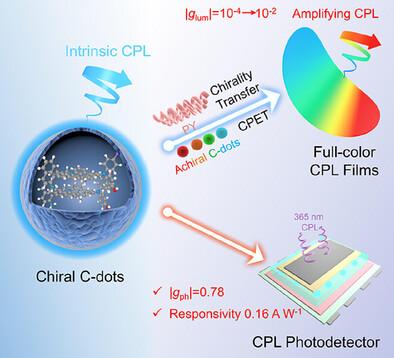空间隔离诱导固态发射手性碳点实现高效圆偏振光发射和检测
IF 19
1区 材料科学
Q1 CHEMISTRY, MULTIDISCIPLINARY
引用次数: 0
摘要
手性碳点(C-dots)是一种具有重要应用前景的新型手性材料,特别是在圆偏振光(CPL)相关应用领域。本文以4,4-二溴三苯胺、(R/S)-1,1′-联萘-2,2′-二胺和对苯二胺为前驱体,通过无溶剂热解制备了固态发射性手性c点。结构分析和理论分析表明,合理的层间距和扩展的共轭结构可以有效地促进固态发射。手性c点表现出强烈的棉花效应和本征CPL发射,不对称因子(|glum|)≈6.9 × 10−4。值得注意的是,引入非手性螺旋聚乙炔触发手性互反转移,导致CPL发射增强,|glum|放大80倍以上。更重要的是,通过圆极化能量转移,诱导的手性进一步转移到一系列非手性c点上,实现了|胶|高达10−2的全彩CPL发射。值得注意的是,用手性c点作为有源层,制备了高效的CPL光电探测器,实现了0.78的最大光电流不对称因子(|gph|)和0.16 a W−1的出色CPL探测响应。据目前所知,这是基于手性c点的CPL光电探测器的第一篇报道。这项开创性的工作开辟了在高度集成的光子平台上使用0D手性发光纳米材料检测CPL的可能性。本文章由计算机程序翻译,如有差异,请以英文原文为准。

Spatial Isolation Induced Solid-State Emissive Chiral Carbon Dots for Achieving Efficient Circularly Polarized Light Emission and Detection
Chiral carbon dots (C-dots) are highly promising for constructing advanced chiroptical materials with significant applications, especially in circularly polarized light (CPL)-related application scenarios. Herein, solid-state emissive chiral C-dots are facilely synthesized through solvent-free pyrolysis using 4,4-dibromotriphenylamine, (R/S)-1,1′-binaphthyl-2,2′-diamine and p-phenylenediamine as precursors. Structural and theoretical analyses demonstrate that reasonable interlayer spacing and extended conjugated structures effectively promote solid-state emission. The chiral C-dots exhibit intense Cotton effect and intrinsic CPL emission, with dissymmetry factors (|glum|) ≈6.9 × 10−4. Significantly, introducing achiral helical polyacetylene triggers reciprocal chirality transfer, leading to enhanced CPL emission with over 80-fold amplification of |glum|. More importantly, the induced chirality is further transferred to a series of achiral C-dots via circularly polarized energy transfer, achieving full-color CPL emissions with |glum| up to 10−2. Notably, with chiral C-dots as active layer, efficient CPL photodetectors are fabricated, achieving a maximum photocurrent dissymmetry factor (|gph|) of 0.78 and outstanding CPL detection responsivity of 0.16 A W−1. As far as known, this is the first report of CPL photodetector based on chiral C-dots. This pioneering work opens up the possibility of detecting CPL with 0D chiral luminescent nanomaterials on highly integrated photonic platforms.
求助全文
通过发布文献求助,成功后即可免费获取论文全文。
去求助
来源期刊

Advanced Functional Materials
工程技术-材料科学:综合
CiteScore
29.50
自引率
4.20%
发文量
2086
审稿时长
2.1 months
期刊介绍:
Firmly established as a top-tier materials science journal, Advanced Functional Materials reports breakthrough research in all aspects of materials science, including nanotechnology, chemistry, physics, and biology every week.
Advanced Functional Materials is known for its rapid and fair peer review, quality content, and high impact, making it the first choice of the international materials science community.
 求助内容:
求助内容: 应助结果提醒方式:
应助结果提醒方式:


